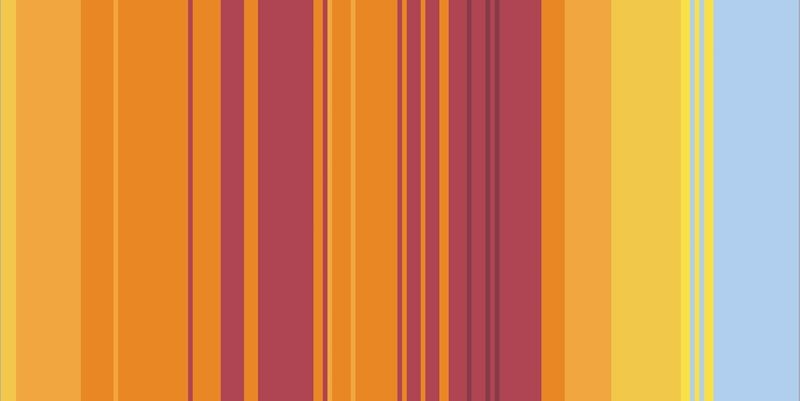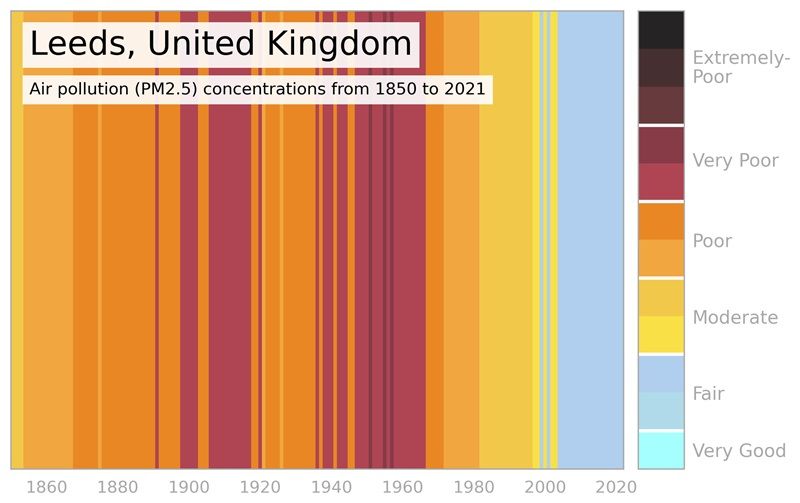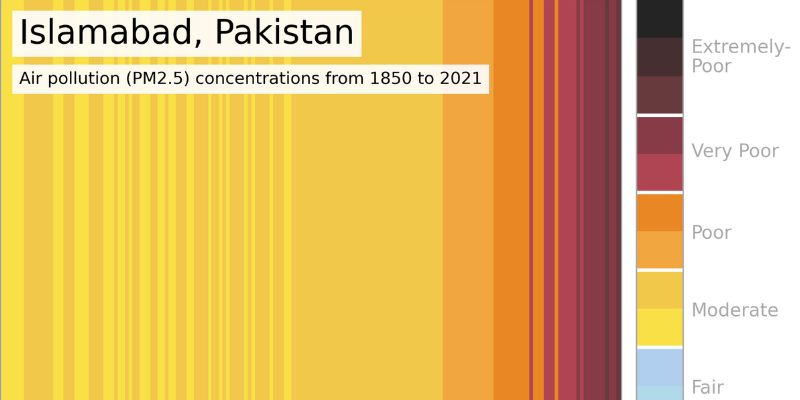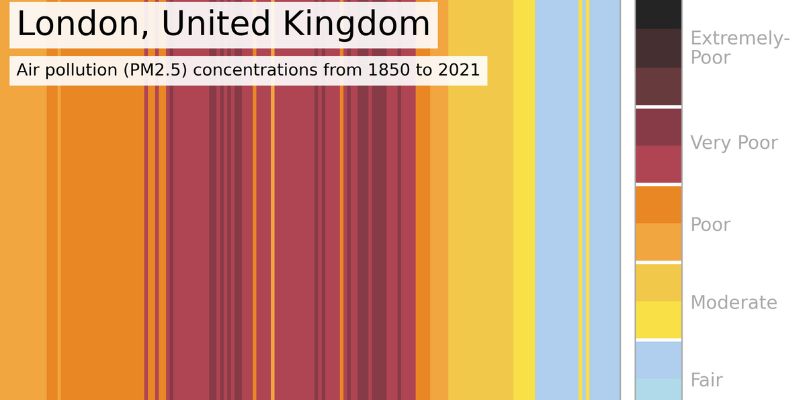
The global concentrations of one of the main air pollutants known to affect human health have been graphically illustrated for the first time by a team of scientists.
The Air Quality Stripes which were created by the University of Leeds, the University of Edinburgh, North Carolina State University, and the UK Met Office, starkly contrast the significant improvements in air quality across much of Europe with the alarming deterioration in parts of Africa and Central Asia.
The project's findings highlight both the successes and ongoing challenges in tackling air pollution worldwide.
The bottom line is that air pollution is one of the world's leading risk factors for death
Dr Kirsty Pringle from EPCC at the University of Edinburgh and co-director of the project, said: “Air pollution is often called the ‘invisible killer’, but these images make the invisible visible, showing the changes in particulate matter pollution over the decades.”
Dr Jim McQuaid, an Associate Professor of Atmospheric Composition in the Leeds’ School of Earth and Environment who worked on the Air Quality Stripes project with Dr Pringle, said: “The bottom line is that air pollution is one of the world's leading risk factors for death, it is thought to contribute to one in ten deaths globally.
“Our Air Quality Stripes show the huge range in trends and concentrations around the world. The stripes demonstrate that there is still more work to be done to reduce people’s exposure to poor air quality, and in some places a great deal more!”

Inspired by the world-famous climate warming stripes image, the researchers created their own illustration to plot the changing trends in outdoor concentrations of what is known as particulate matter air pollution, a mix of tiny liquid or solid particles such as dust, dirt, soot, or smoke, which are found throughout the atmosphere.
Dr Steven Turnock, a senior scientist from the UK Met Office who provided the data for the Air Quality Stripes project, said: “Presenting this scientific data as Air Quality stripes really brings into focus the stark contrast in air quality trends and people’s exposure to poor air quality depending on where they live.”
There are stripes for the capital city of every nation worldwide with two additional cities for China, India, and the United States. The research team also included their own cities of Leeds, Edinburgh, and Exeter.

The lightest blue stripes meet the World Health Organisation Air Quality Guidelines which were introduced in 2021, with all other colours exceeding the guideline values.
Data from computer simulations and satellite observations were combined to estimate the changing concentrations of particulate matter since the beginning of the industrial revolution, with the colour palette for the stripes devised by an artist who analysed over 200 online images of “air pollution” to identify the dominant colour palettes.
Key findings:
- Europe's Air Quality Gains: The images show substantial reductions in particulate matter levels across most of Europe (predominantly Western Europe). Stricter air quality regulations and technological advancements have successfully reduced particulate matter concentrations in most European cities (e.g. London, Brussels, Berlin).
- Worsening Conditions in Central Asia and parts of Africa: The visualisations reveal a concerning rise in particulate matter pollution in many cities in central Asia and Africa (e.g. Islamabad, Delhi, Nairobi). Rapid urbanisation, industrial growth, and limited regulatory frameworks are contributing to this troubling trend, which poses significant health risks to local populations.
- Global Disparities: The images highlight the stark disparities in air quality progress between different regions, emphasising the need for targeted international efforts to address the growing air pollution crisis in the most affected areas.
- The influence of natural sources was particularly notable in some locations, these sources include desert dust and wildfires, proximity to the coast was often quite noticeable with locations such as Jakarta having lower levels than might be expected.
A cocktail of pollutants
Particulate matter, or PM2.5, have a diameter less than a 30th of the width of a human hair and can penetrate deep into our lungs easily. The smallest particles cross into the bloodstream and affect our health, and some have even been detected in the blood of unborn children.
They can come from natural sources such as volcanoes and deserts but are also produced by human activities such as industry, cars, agriculture, domestic burning, and fires arising from climate change.
PM2.5 has been linked to a very wide range of health issues ranging from breathing problems like asthma, to reduced lung health, increased likelihood of developing cancer and heart disease, and an increased risk of developing many diseases including diabetes, Alzheimer’s, and Parkinson’s.
The World Health Organisation recommends that the annual average concentration of PM2.5 should not exceed a concentration of 5 micrograms per cubic meter air (5 ug/m³). This new guideline is a concentration which is generally classed as very good air quality. It is important to remember that there is NO safe level of PM2.5 recognised by medical science.
At present, 99% of the world’s population live with concentrations above this value, with the highest PM2.5 levels typically found in low- and middle-income countries.
The AQ stripes use an annual average to take account of the ups and downs due to changes in weather patterns throughout the year, and to make comparison between locations simpler. However the researchers point out that even short-term exposure to very high levels can quickly have acute health effects requiring medical treatment.

Dr McQuaid added: “We created these to try to illustrate the complex data that computer models generate, into something that is much easier to understand.
“Strangely, one of the major headaches for us was the colour scheme. We finally went for blue to black, representing nice clean blue skies, through to black for extremely high levels of pollution.
“In the end we contacted a colleague in the US (Douglas Hamilton) and he worked with one of his team to create a colour scheme using an internet search of images tagged as ‘air pollution’ and they came up with what we finally went with. It was very similar to what we already had, but great to get external validation.
“To me it’s all about that lightbulb moment when someone understands it; that sudden ‘oh yeah now I get it!’ I wanted it to be simple enough that non-experts could look at it and be able to understand it without having done science since leaving school. “
Dr Pringle added: “The images show that it is possible to reduce air pollution; the air in many cities in Europe is much cleaner now than it was 100 years ago, and this is improving our health. We really hope similar improvements can be achieved across the globe.”
The Air Quality Stripes follow in the footsteps of the Climate Warming Stripes which were created by Professor Ed Hawkins at the National Centre for Atmospheric Science and University of Reading in 2018 and have since become very widely used as a visual representation of the Earth’s warming climate.
Professor Hawkin’s work has since inspired the creation of the Biodiversity Stripes which show biodiversity loss, and Ocean Acidification Stripes.
Further information
Top image: Cropped Air Quality stripes for Leeds
The initiative is a collaboration between leading environmental research institutions and data science organisations EPCC and CEMAC. Led by the universities of Leeds and Edinburgh, the project aims to provide valuable insights into air quality trends and support efforts to mitigate air pollution worldwide. EPCC at the University of Edinburgh is a leading data science hub. The work was supported by the Software Sustainability Institute which is dedicated to supporting researchers in their use of software.
The University of Leeds and the University of Edinburgh are both members of the Met Office Academic Partnership (MOAP)
For more information, please visit airqualitystripes.info
For media enquiries, Please contact the University of Leeds press office via pressoffice@leeds.ac.uk